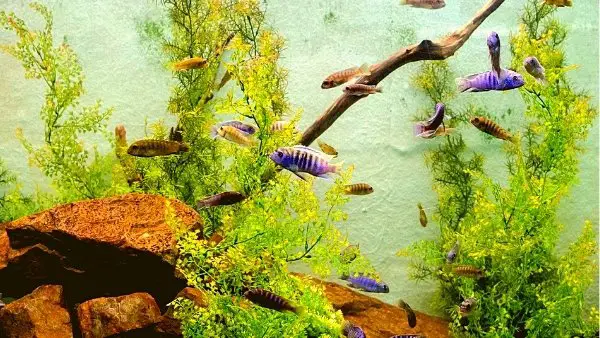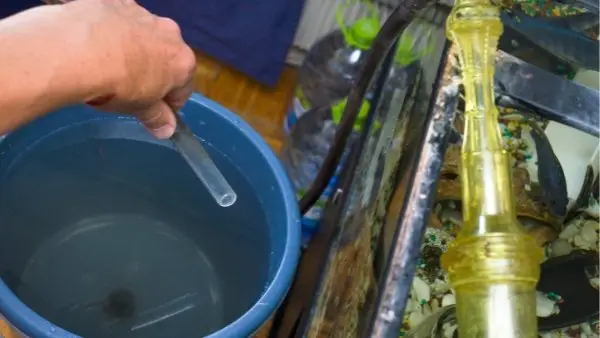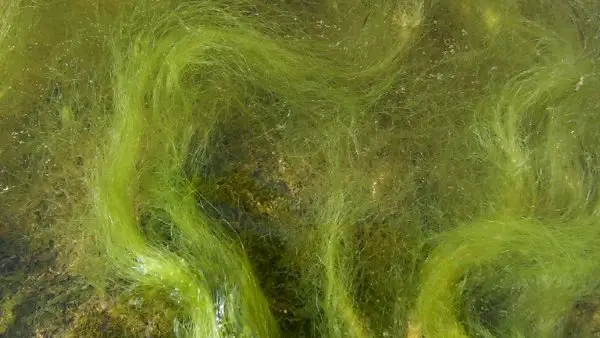Algae growth in your aquarium is all but inevitable and will happen at some stage in your hobbyist journey, probably multiple times too! Some algae growth is actually beneficial and normal for your tank, especially if you have a well-established one. However, if you notice excess algae growth and don't act on it, you will likely witness your fish and plants become very unwell in front of you.
The majority of algae we see as hobbyists comes in the form of brown, green, red, or even film and it is usually first noticed residing on your tank glass or walls, plants, rock, and other aquarium décor. Fortunately, there are several ways to prevent this from happening, and also there are ways to remove and control an outbreak that is already in progress. Of course, it will help if you regularly clean your fish tank, you will not experience as many algae, however, it is still somewhat of an inevitability.

What Are The Causes Of Algae Overgrowth?
When you break it all down, algae are plants, and like most plant life, algae thrive on water, light, and nutrients. If you are providing too many of these variables, then you will see huge spikes in your tank's algae, just like ivy or weeds growing in a garden.
Your fish tank, for obvious reasons, needs water, so you cannot help that factor, however, you can certainly control the amount of light exposure and nutrients that your tank is exposed to.
Light
Exposing your aquarium to too much light can play a huge factor in this. Sure, your other plants will benefit from natural and LED lighting, but you don't need to keep your tank constantly lit up, it is healthy for your lights to be turned off and not kept on 24/7. If your aquarium is next to a window, receiving a lot of direct natural sunlight, perhaps look into moving it, or at least moving it out of the way of direct sunlight every few days. A good idea is to install an LED aquarium blue light if you want to avoid alae outbreaks, whilst maintaining a good aquarium light.
Water
Going too long between water changes will almost certainly lead to more algae being produced. Not only this, you will run the risk of your fish picking up nasty diseases from the dirty water too. The best thing to do is simply change your tank's water more regularly to keep the water quality good and clean.

Overfeeding
It is a well-known thing that overfeeding your fish tank will likely lead to a whole host of issues with your aquarium and more importantly your aquarium's inhabitants. Reduce the amount you are feeding your tank, or introduce certain shrimp or other invertebrates to take care of the leftovers.
How To Avoid Algae Growth
Now that we have discussed what causes the growth of algae within your aquarium, it makes sense to find out what solutions there are to prevent or fix an algae infestation!

Reduce Lighting
Avoid placing your tank in direct sunlight even briefly, sunlight will certainly promote the growth and spread of algae. When you use an LED light, make sure it isn't too strong as that will also encourage rapid algae growth. Additionally, make sure that you only have your aquarium lights on for 8 hours a day and 10 at the very most.
Less Feeding
The best way to not overfeed your fish is by simply not feeding them as much. Trial and error may have to be performed over the period of a few days to measure and see how much your fish will actually eat and how much they will leave and let ruin your tank's water quality.
A good way to measure fish overfeeding is if there is still food left over after 5 minutes has passed since you fed the tank. If this is still the case then you will know how much you should feed them and also can remove the uneaten food.
Water Changes
Certainly one of the best ways of avoiding algae is by changing your water regularly. Changing 10% to 15% of your aquarium water on a weekly basis will keep nutrients in your water low, helping stunt the growth of your out-of-control algae!
Manual Removal
If you discover algae on your live rock or aquarium walls, manual removal is a fantastic option as it yields instant results. There are many tools which will help with this, and some are not so useful. An algae scrubber is top of our recommendations as it is a tool designed specifically for manual algae removal, it is a soft sponge that consists of non-toxic melamine foam and won't scratch or damage your algae-infested areas. Additionally, if you are having a tough time with some of the more stubborn types of algae, you can use a Mag-Float Glass Cleaner with scraper blades. The scraper blades are glass-safe and also cut through the stubborn algae with ease.

Keep Your Own Live Plants
If you don't already keep live plants, then it is certainly a good idea to add them to your tank. They will help to absorb a lot of the nutrients that algae need to thrive, so, the fewer nutrients in the water, the less algae growth!
Keeping Algae Eating Fish
Algae don't just appear in freshwater tanks, the algae problem is common in both fresh and saltwater aquariums. So, purchasing yourself an awesome freshwater algae-eating fish will certainly help reduce the algae numbers whilst providing a tasty meal for your fish. The same applies to saltwater aquariums, there are a plethora of brilliant saltwater algae eaters too, so check them out and take your pick! The ever-popular guppy fish is a good algae eater, however, they have a balanced and mixed diet, so will not eat algae all the time.
Types of Algae
It is important that before you even consider removing the algae you discover in your tank that you can identify what it is. Knowing the different types of algae will help you find a solution for them. Here are the most common types of algae and how to handle them.
Brown Algae
Brown algae, which is also known as gravel or silica algae are commonly found in new aquariums. They tend to coat the tank in sheets, which is good because it is easy to wipe off and remove. This algae is pretty harmless and will usually disappear once your tank becomes more established and mature. Regarding lighting, if you have brown algae you can increase your light intensity to help get rid of it.

Blue-Green
Blue-green algae, also known as slime algae is usually caused by excess nitrate and phosphate in your water. This algae grows and spreads incredibly fast, especially if the water in your tank is not regularly cleaned and is dirty. Another reason why you should remove this algae immediately if found is that it harms a lot of the beneficial bacteria in your tank and also your tank's biofilter!
Red or Beard Algae
This alga is most certainly the hardest to remove, and it nearly always appears or spreads onto your plants too, making matters much worse. A dip in a weak bleach solution (5% - 10%) for a couple of minutes will usually kill this algae off.
Green Algae
Green algae are also commonly known as green hair algae, and even thread or spot algae. This algae is certainly healthier than the other types and will almost 100% appear in your tank at one stage or another. As long as your tank and everything in it is healthy and well cared for this alga shouldn't overgrow. Green algae are one of the more favored foods for saltwater and freshwater algae eaters, so by using them in your tank you will likely not see the numbers blow up too much.

Green Water
Green water is also well-known as algae bloom, which is caused by the excessive growth of microscopic algae that has been suspended in the water. This alga is certainly stubborn too as it cannot be scraped or wiped off surfaces like most other algae. This alga will not necessarily go away if you constantly change your water, the best way of removing it is by taking your tank out of sunlight and reducing the amount of LED light in your tank each day.
Final Thoughts
In conclusion, as a hobbyist you should always expect an algae invasion at some point, so, the best thing to do is correctly prepare yourself for it. By knowing how to quickly ID the algae and also by knowing how to prevent and remove the various types of algae, you will be completely ready to handle an overgrowth in your aquarium.
